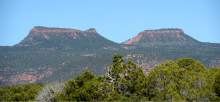This is an archived article that was published on sltrib.com in 2016, and information in the article may be outdated. It is provided only for personal research purposes and may not be reprinted.
Utah Wildlife Board members are joining a chorus of state-level opposition to the proposed Bears Ears National Monument in southeastern Utah by sending a letter to U.S. Interior Secretary Sally Jewell that outlines their concerns.
The board sent a letter Wednesday that contends the designation would impact hunting, fishing and trapping and put at risk thriving populations of a plethora of wildlife including elk, deer and bighorn sheep.
"It is imperative that the state of Utah manage its wildlife resources if we are to continue seeing the robust wildlife populations and high-quality wildlife recreation the area is known for," the letter says.
The letter is the latest jab in the back-and-forth between monument supporters and opponents over the last several months over a proposal that has generated high emotions on both sides.
A coalition of tribes wants President Barack Obama to designate the 1.9-million acre a national monument to ensure protections for lands considered sacred. The area is home to an estimated 100,000 archaeological sites that include ancient cliff dwellings.
Utah's GOP leaders and many rural residents fiercely oppose the plan, arguing that a monument would become another layer of unnecessary federal control and close the area to development and recreation.
They instead support a bill that would protect about 4.5 million acres in the state, including 1.4 million acres of the Bears Ears area, and in exchange open up 1 million acres for recreation and oil and gas development.
Jewell visited the area last month and held a public meeting — the latest indication that President Barack Obama's administration is seriously considering the proposal.
The push for the Utah monument comes as conservationists in Arizona, Nevada, Maine and elsewhere also advocate for Obama to designate new national monuments as he puts the final touches on his environmental legacy. Proponents are also looking to greater protections for vast swaths of ocean bottom off the coasts of New England, California and Hawaii.
The Utah wildlife board said in the letter that if a monument is created, they hope the federal government would allow the state to continue to manage wildlife in the area. That's the setup at the Grand Staircase-Escalante National Monument, created in 1996, the board said.
In the letter, board members argue that the abundance of wildlife and recreational opportunities in the area is due to the collaboration of state officials and sportsmen organizations.
Board chairman John Bair writes in the letter that a change in management practices would "threaten the progress we as a state have made in restoring and enhancing wildlife populations found there, and impair wildlife related recreational use and enjoyment of this truly special area."



